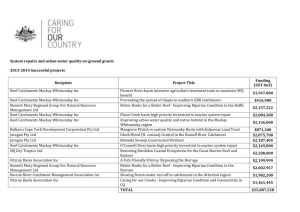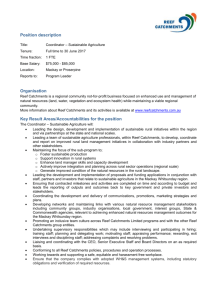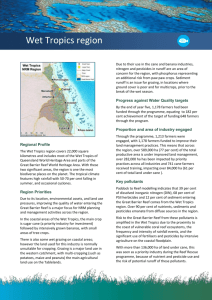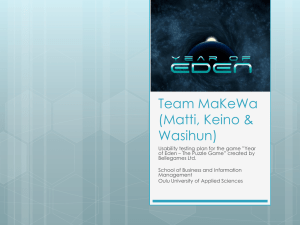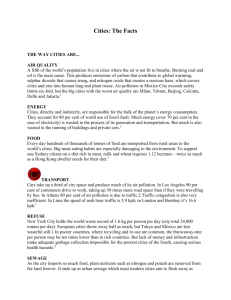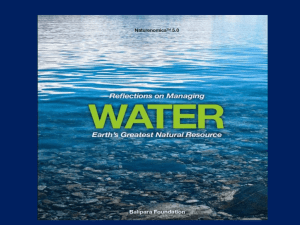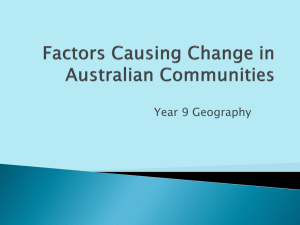DOCX - 737.28 KB
advertisement
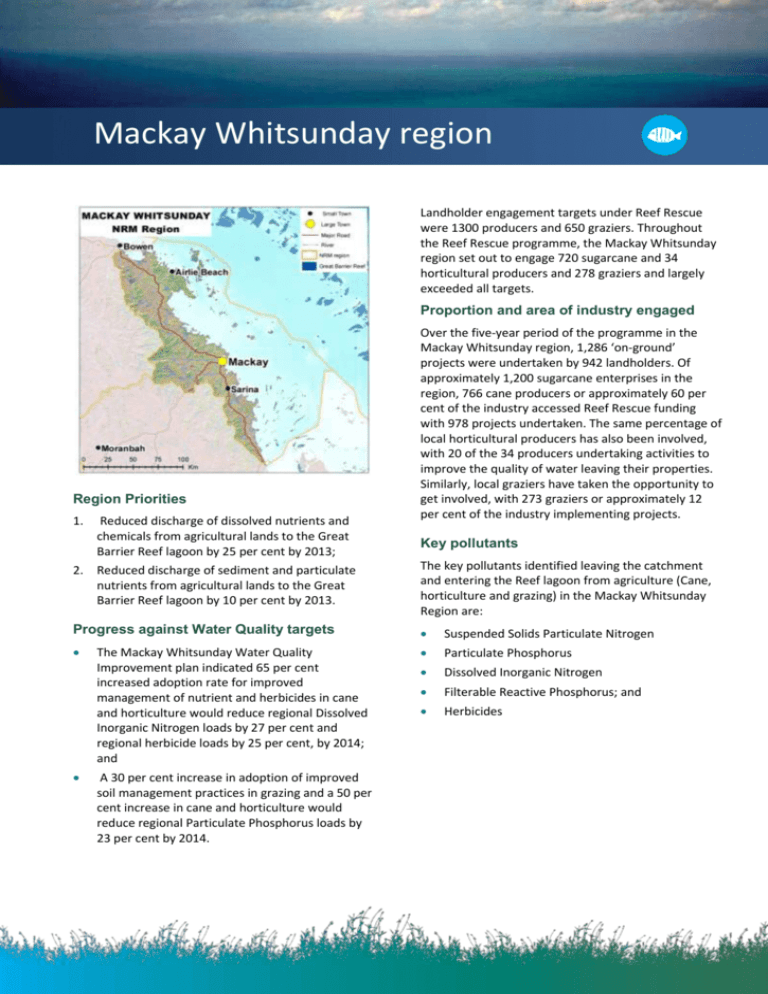
Mackay Whitsunday region Landholder engagement targets under Reef Rescue were 1300 producers and 650 graziers. Throughout the Reef Rescue programme, the Mackay Whitsunday region set out to engage 720 sugarcane and 34 horticultural producers and 278 graziers and largely exceeded all targets. Proportion and area of industry engaged Region Priorities 1. Reduced discharge of dissolved nutrients and chemicals from agricultural lands to the Great Barrier Reef lagoon by 25 per cent by 2013; Over the five-year period of the programme in the Mackay Whitsunday region, 1,286 ‘on-ground’ projects were undertaken by 942 landholders. Of approximately 1,200 sugarcane enterprises in the region, 766 cane producers or approximately 60 per cent of the industry accessed Reef Rescue funding with 978 projects undertaken. The same percentage of local horticultural producers has also been involved, with 20 of the 34 producers undertaking activities to improve the quality of water leaving their properties. Similarly, local graziers have taken the opportunity to get involved, with 273 graziers or approximately 12 per cent of the industry implementing projects. Key pollutants 2. Reduced discharge of sediment and particulate nutrients from agricultural lands to the Great Barrier Reef lagoon by 10 per cent by 2013. The key pollutants identified leaving the catchment and entering the Reef lagoon from agriculture (Cane, horticulture and grazing) in the Mackay Whitsunday Region are: Progress against Water Quality targets Suspended Solids Particulate Nitrogen Particulate Phosphorus Dissolved Inorganic Nitrogen Filterable Reactive Phosphorus; and Herbicides The Mackay Whitsunday Water Quality Improvement plan indicated 65 per cent increased adoption rate for improved management of nutrient and herbicides in cane and horticulture would reduce regional Dissolved Inorganic Nitrogen loads by 27 per cent and regional herbicide loads by 25 per cent, by 2014; and A 30 per cent increase in adoption of improved soil management practices in grazing and a 50 per cent increase in cane and horticulture would reduce regional Particulate Phosphorus loads by 23 per cent by 2014. Regional Funding The investment of over $32 million into the region by the Australian Government has produced a range of benefits from the improvement in water quality through investment in cane, grazing and horticultural industries, investment in industry bodies, extension services and other support to the local economy, including job creation. Coinvestment from landholders and industry has resulted in over $88 million directly invested to improve the quality of water draining into the Great Barrier Reef Lagoon. Adoption of technology that enables cane farmers to apply variable rates of fertilisers so that nutrients are applied according to the ability of the crop to utilise the nutrients, and less nutrients move from the paddock with irrigation or rainfall. Sub-surface application of nutrients is now widely adopted in the cane industry, which also reduces the likelihood of nutrients being lost into waterways. Construction of sediment / nutrient retention basins to capture sediment and potentially recycle nutrients back onto the property through subsequent irrigation. Adoption of improved herbicide application techniques (including shielded sprayers) and timing to target specific weeds to reduce the amount of herbicide required to maintain a weed free crop, and reduce the risk of herbicides leaving the property following rainfall. Load reductions Modelled load reduction estimates from the Reef Plan Paddock to Reef programme indicate the following load reductions for the Mackay Whitsunday region between 2009 and 2013: 24 per cent reduction in annual average dissolved inorganic nutrient load between 2009 and 2013. 9 per cent reduction in annual average sediment. 11 per cent reduction in annual average particulate nitrogen load. 13 per cent reduction in annual average particulate phosphorus load. 42 per cent reduction in annual average PSII pesticide load. Key Achievements The delivery of the programme in the Mackay Whitsunday region has exceeded expectations to fast track management practice changes in the cane, grazing and horticulture industries leading to significant reductions in the pollutant load reductions entering the GBR lagoon. All activities funded were validated for water quality improvement outcomes under the Paddock to Reef Programme. Cane Adoption of controlled traffic systems on farms whereby the track width of all equipment is the same and matches row width, so that less soil compaction occurs and water infiltration rates increase. Adoption of more efficient irrigation practices to ensure even application of water; which ensures less soil movement due to irrigation and, so soil, nutrients and herbicides remain in the paddock. Grazing Fencing off of watercourses, to protect stream banks from stock trampling and prevent fouling of water from cattle dung. Establishing ‘off-stream’ watering points so that cattle do not rely on creeks for their direct water supply, which also improves production from cattle and makes mustering of stock easier. Increased monitoring of pastures to enable graziers to make decisions about stock rotations and stocking rates based on pasture availability. This improves productivity from cattle and enables graziers to make earlier decisions about adjusting stocking rate according to seasonal conditions. Horticulture Adoption of improved, low intensity irrigation systems to improve water use efficiency and reduce the chances of soil, nutrient and pesticide losses. Adoption of mulching technology to reduce the impact of weeds and reduce the requirement for herbicides. Use of improved pesticide application technology to reduce the risks of chemical losses. Case study: Cane – Mackay Whitsunday Considered an innovator in the industry, Marian cane farmer and award finalist Rodney Lamb has a history of adapting and trialling new equipment to increase environmental and economic benefits for growers. Through the Reef Rescue programme Rod has been working to adapt his inter row spray shields to only spray when there is a weed detected by a sensor nozzle, in what is known as a WeedSeeker. This adaptation has huge potential to reduce herbicide applied over cane properties and the knowledge gained through Rod’s work will be shared by the industry as a whole. Rod has also been involved in the Paddock to Integrated Monitoring, Modelling and Reporting Program, providing the program with his land and labour for a paddock monitoring trial that has run since 2009. The trial began with two treatments comparing conventional and best management practices and has expanded to included two more treatments comparing banded and broadcast use of residual herbicides. These trials have been in important in improving local understanding of best practices sugarcane management and encouraging the grower community to take up improved practices. Rod has also utilised the Reef Rescue programme to adopt a swathe of improved practices across his farm including moving to two metre row spacing on permanent beds with GPS guided controlled traffic on all operations. This has reduced compaction and increased retention of water, nutrient and chemicals on Rod’s property. Rod has also purchased an eight-row legume planter and low-pressure overhead irrigation, which is used to incorporate nutrients and chemicals to reduce run off wherever possible. Marian canefarmer, Rodney Lamb (centre) at a field day. Photo: Queensland Farmers Federation
